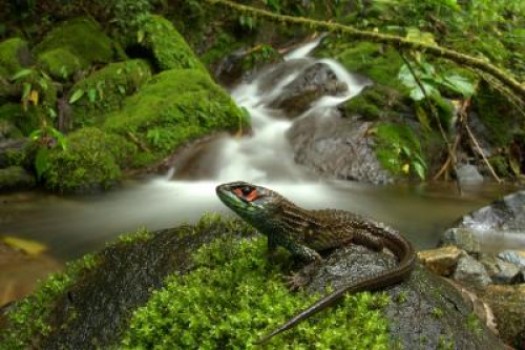Special delivery! See our visiting baby camels (Dec. 6–19) and yaks (Dec. 20–Jan. 5) this holiday. Learn more
Science News
Diverse Manu National Park
February 24, 2014
by Molly Michelson

Manu National Park in Peru is one of the most biodiverse spots on the planet. Encompassing the lowland Amazonian rainforest, a high-altitude cloud forest and Andean grassland, the reserve covers about 18,811 square kilometers (or over 7,000 square miles).
It’s also a Conservation International Biodiversity Hotspot, a UNESCO Biosphere Preserve and a World Heritage Site, plus home to four Amazonian tribes and a nomadic group of hunter-gatherers known as Mashco-Piro.
And, like many natural wonders on our planet, Manu National Park experiences extraordinary threats. The devastating chytrid fungus has caused a decline in the number of frogs there, while deforestation—to support subsistence living, gold mining, and oil and gas drilling—encroaches on the buffer zones around the park.
In attempt to document its biodiversity and pressure officials for more protection of the park, scientists have published an extensive survey of the amphibians and reptiles in the area.
Other life in Manu was already well catalogued: more than 1,000 species of birds (about 10 percent of the world’s bird species!) and 1,200 species of butterflies have been recorded in the park. Now add to that 287 reptile and amphibian species.
Rudolf von May, a Peru native and postdoctoral researcher in UC Berkeley’s Museum of Vertebrate Zoology, and Alessandro Catenazzi, of Southern Illinois University Carbondale, have spent more than 15 years each scouring the park and its surrounding areas for frogs, toads, salamanders and caecilians—all amphibians—as well as for reptiles such as snakes, lizards, turtles and caimans. The field work in the park and its buffer zone, augmented by other, more limited surveys published previously, allowed the team to compile a list of 155 amphibian and 132 reptile species, including a handful of species new to science.
“For reptiles and amphibians, Manu and its buffer zone now stands out as the most diverse protected area anywhere,” says von May. The previous record for the most diverse protected area for reptiles and amphibians was in Yasuní National Park in Ecuador, which hosts 150 amphibian and 121 reptile species, according to a 2010 study.
To assemble the Manu list, the team surveyed multiple elevations and examined hundreds of museum specimens collected at dozens of locations in Manu National Park and its buffer zone. Analysis of DNA sequences and frog calls allowed the team to identify additional species, including the glass frog Centrolene sabini, the world’s 7,000th known amphibian species.
“There is no place like Manu where we can preserve such an exceptionally large amount of biodiversity, as well as the evolutionary processes that contribute to maintain and promote biodiversity,” says Catenazzi. “It is our responsibility to make sure this biological legacy is passed on to the next generations.”
Image: Alessandro Catenazzi, Southern Illinois University